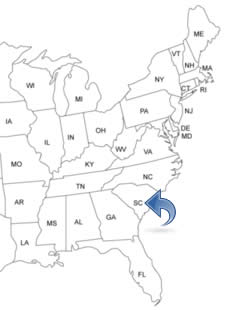SOUTH CAROLINA PEOPLE SEARCH!
- ✔ Contact Info
- ✔ Phone Numbers
- ✔ Criminal Records
- ✔ Income Info
- ✔ Neighbors
- ✔ People's Age
- ✔ Property Ownership
- ✔ And Much More
Charleston, South Carolina
Charleston is located in the eastern part and is (2016) the largest city in the U.S. State of South Carolina. The Holy City. Charleston is dominated by church steeples and has practically no tall buildings in downtown. Charleston is ranked as the friendliest city in the USA. The city is a major tourist destination, attracting nearly 4 million visitors a year, and is well-known for its unique culture with museums, historical sites, and other attractions.
To See And To Do In Charleston
- Church Tour
- Charleston Museum
- Gibbes Museum Of Art
- The Market Shopping District
- The Battery And White Point Gardens
- Charles Towne Landing State Historic Site
- Fort Sumter
- Liberty Square
- Patriots Point Naval and Maritime Museum
- French Quarter
- Longitude Lane
- Arthur Ravenel Bridge
- The Citadel
- Waterfront Park
- Take A Carriage Tour Of The City
History Of Charleston - Timeline
In 1670, the village was established across the Ashley River by English settlers and was called Charles Town after Charles II of England, Scotland, and Ireland. In 1672, there were 30 houses and about 300 settlers in the village. In 1682, St. Philip's Episcopal Church was built.
In 1690, Charleston officially moved to its current site. About 1,200 people lived there at the time. In 1695, city walls were constructed and the John Lining House was built. In 1698, many African slaves were coming and a new law provided a cash incentive for bringing white servants into Carolina and Charleston. Also in 1698, hundreds of people died of yellow fever and smallpox and a fire destroyed many buildings in the town.
In 1700, a free library opened on St. Philip's Street. In 1718, four ships sailed into Charleston Harbor. It was Blackbeard the Pirate and his men and they took hostages for ransom. In 1728, passenger and shipping service was established between Charleston and New York City. In 1736, the first theater building in the USA was built in Charleston.
In 1752, a hurricane killed nearly a hundred people in the town. In 1773, the first American museum opened in Charleston, the Charleston Museum. In 1783, the city was incorporated and officially adopted the name Charleston. In 1778, Charlestown Gazette newspaper was published and in 1785, The Charleston Evening Gazette newspaper was published.
In 1800, more than 18,800 people were living in the town. In 1803, a newspaper, the Charleston Courier, was founded. In 1818, Samuel Morse, who later invented the telegraph, opened a printing business in the city. In 1830, a steam locomotive, The Best Friend, started a regular passenger service between Charleston and Hamburg in South Carolina. It was the first steam locomotive in America to pull passengers in regular service.
In 1843, The Citadel, The Military College of South Carolina, opened at Marion Square in downtown Charleston. In 1861, Citadel cadets from Charleston fired the first shots of the American Civil War. They opened fire on the Union ship, Star of the West when it was entering Charleston's harbor. The Star of the West was a civilian steamship hired by the United States government to transport military supplies.
In 1867, the Avery Institute was established. It was the first free secondary school for blacks. In 1896, the United States Post Office and the Courthouse were completed. The same year, a powerful earthquake hit the area of Charleston. Many buildings were destroyed and between 60 and 110 lives were lost.
In 1900, there were more than 55,800 living in Charleston. In 1925, Dubose Heyward pens the novel Porgy and in 1934, the composer George Gershwin visits Charleston to research and write the first American opera, Porgy and Bess. In 1963, in Charleston, the Rivers High School became the first integrated high school in the state of South Carolina.

